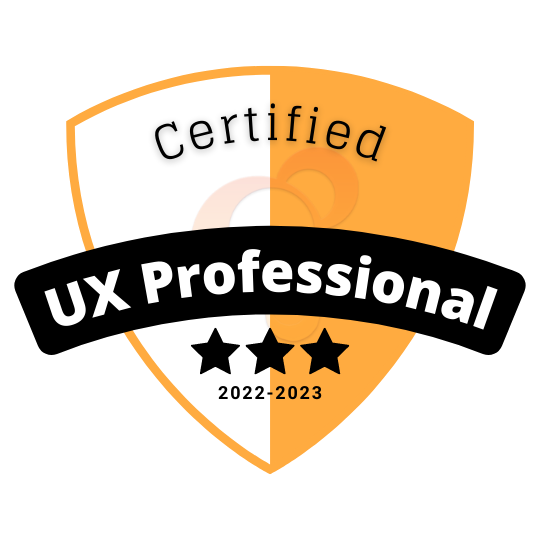WHY UX DESIGN?
Everyone’s reasons for learning UX are a little different.
Developers. You created your own app, but every time someone downloads it, they struggle to use it. And if your users are telling you this, then you know it’s really bad.
Graphic and UI designers. UX is about the most natural skillset you can add to your career. Tons of employers need it – and are willing to give you a nice 5-figure salary bump if you can do it. Learning UX is a clear win.
PMs. Your job is already like 25% UX designer. Would be nice to level up those skills.
Entrepreneurs and hustlers. You’re already burning the candle at both ends to make your app a reality, but you know that if users find it frustrating and confusing, it won’t matter how many hours you put into it.
Non-tech folks. You want a job in tech, but you don’t want to be a coder. That Psych degree better start paying for itself sometime, and UX is basically ergonomics of the mind. Time to level up.
Go from zero to pro-level UX design.
UX Designing
Course 1: Basic
Intro to the Basics of User Experience (UX) Design
Duration: 3 hours
What will you Learn?
Describe what user experience design is and why it's important
Describe the principles of great user experience design
Describe the process you should follow to design a great user experience
Describe the skills and knowledge that you need to be a user experience professional
Describe the obstacles that are common to great user experience design and how to overcome them
Know what to do as the next step for you as a user experience professional
Requirements
This course assumes that you have some familiarity with design at a high level and that you have an interest in either being a user experience professional or working with one.
Description
Learn the fundamentals of UX (user experience) design and process.
If you design a product that people interact with, then you are designing a user experience. If you want your product to be easy to use, engaging, what people expect, and meet the goals of the organization, then you want to make sure you design an optimal user experience. In this course, you will learn the basic principles, and processes of good user experience, and what a user experience professional should know and be able to do.
Examples of what is in the course:
What is user experience?
What makes a user experience good?
Principles of a great user experience
UX Roles
The skills and knowledge that a user experience professional needs
The obstacles to great user experience design and how to overcome them
and much, much more!
Get started now and learn the basics of user experience right away.
Who is this course for?
People who are interested in becoming a user experience professional
Aspiring UX Professionals who want to see how their knowledge and skills line up with what is expected of UX professionals in the field
Course 2: Advanced Basics
User Experience (UX) Design Fundamentals
Duration: 6 hours (1hr x6 weeks) | Fast track: 6 hours (2hrs x 3 weeks)
Welcome to your UX design Fundamentals course. Over these six lectures, you’ll be introduced to the entire UX design process as you carry out your very first UX project: designing an app that helps people who work remotely. You’ll start from the very beginning with some user research and project ideation, then you’ll carry your idea all the way through to a tested prototype! Let’s get started.
Lecture 1: An Introduction to User Experience Design (45min - 1hr)
Dive into the solid introduction to UX design— what it is, why it matters, and the basics of how to do it?
Lecture 2: How to Develop Empathy and Define UX problems (45min - 1hr)
Dive into the first two stages of the Design Thinking process as you learn key user research methods and how UX designers prioritize and focus on the design problems that they’ll solve.
Lecture 3: Introduction to UX Ideation Techniques (45min - 1hr)
Now let’s explore the third stage of the Design Thinking process. You’ll learn a variety of ideation techniques and come up with an idea for a mobile app that solves the problem you’ve identified.
Lecture 4: Introduction to UX Prototyping (45min - 1hr)
It’s time to take your idea and put it into action! In this tutorial, you’ll learn how UX designers use prototypes, identify three different kinds of prototypes, and create a prototype for your mobile app.
Lecture 5: How to conduct User Testing? (45min - 1hr)
Here, you’ll get a taste of the final stage of the Design Thinking process as you conduct some user testing with the prototype you’ve built. Ready for some user feedback? That’s what testing is all about!
Lecture 6: How to become a UX Designer? (1 hr)
Finally, let’s round up everything you’ve accomplished in the course so far with an overview of the Design Thinking process and a deeper dive into what it actually takes to become a UX designer.
LIVE UX Training + Co-op (NEXT BATCH)
Course 1: Intro to the Basics of User Experience (UX) Design
10:00 AM - 1:00 PM (Saturdays)
Live Online
CAD 299.99 only
BOOK YOUR TRAINING TODAY!
BOOK YOUR TRAINING TODAY!
KNOW YOUR TRAINER
Strategic User Experience Design professional with an MBA from the UK and 12+ years of international experience delivering strategic advertising and marketing solutions/ experience design for small to large organizations. Also, a digital native and integrated designer with a passion for UI/UX and digital marketing communications from a 360° perspective.
Prasanth Karunakaran
UI/UX Design Project Manager | Creative Design Lead.
Skilled in managing multiple vendors and cross-functional teams for various projects and clients. Experienced in initiatives related to market research and analysis, branding, advertising & marketing, user interface & user experience, internet marketing and more. Broad industry exposure (Banking and insurance, Restaurant/ QSR, FMCG, Telecom, Entertainment, Fashion, Textile and Apparel, Resources) and working with teams and clients across different geographies (APAC, EMEA, North America).
Creative marketing skills with demonstrated ability to multi-task and set priorities within tight timelines and high client expectations. Good understanding of technical and business concepts. Deft in visualizing clients requirements in the form of UX workflows that aligns with stakeholder’s intent and business goal.




